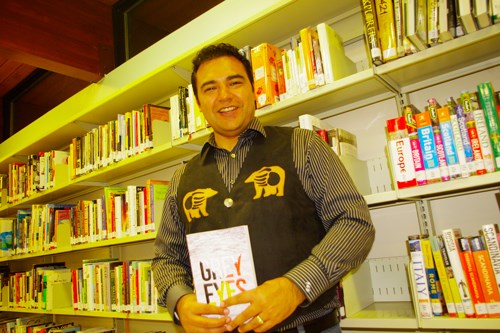The legends that inspired Frank Christopher Busch's novel Grey Eyes were learned in Northern Manitoba, where he lived as a child, but the catalyst for putting his versions of them down on paper were the stories he heard while working for a Winnipeg law firm interviewing about 800 residential school survivors.
"I started in a hotel room," the Nisichawayasihk Cree Nation member told attendees of his reading at the Thompson Public Library on Sept. 8.
It was May 8, 2012 and, after interviewing 12 survivors that day, Busch said the writing was therapeutic. He powered his way through the first draft, completing it in about three months and finding a publisher four months afterwards, both accomplishments being something Busch admits are not common for writers, especially those who don't primarily consider themselves such.
"I got a pretty quick response," Busch said, noting that his professional background is in numbers rather than words, something he also told his editor. "I'm a pretty good writer for an accountant."
The idea for the book and the source of its title were stories he had heard growing up in South Indian Lake and Lynn Lake about grey-eyed people that he was reminded of when his son Evan was born with grey eyes. Busch wanted to tell these legends to his son and initially thought he would write a few children's books about the seven teachings but the project soon became much bigger than that, ballooning into plans for seven novels.
"I've actually mapped out all seven," said Busch, whose reading in Thompson was his fourth that day -the first having taken place at Nisichawayasihk Cree Nation at Nelson House, followed by two more at R.D. Parker Collegiate.
The main character in his book - Little Grey Bear Boy - epitomizes the leadership, magic and charisma associated with grey-eyed people in the legends, while his people's foes, who have red eyes, possess the same qualities, though they only use them to benefit themselves. Besides providing entertainment, however, the book, in telling the tale of a life lived without the influence of colonization, aims to do what the people it is written for often told Busch they desired.
"They kept saying, 'I want my culture back,'" Busch says of the residential school survivors he talked to, for whom no legal settlement could ever fully redress the wrongs they'd suffered. "How do you quantify a culture? What's a language worth?"
The book is dedicated to the "lost children of Turtle Island," and reads, in part, "May you find in these pages that which was wrongfully taken from you."
Busch, who now lives in Westbank, B.C. near Kelowna - on of the three wealthiest First Nations in the country, he says, with a Wal-Mart on the main reserve - did not attend residential school himself but says when he was attending West Lynn Heights in Lynn Lake some teachers weren't interested in getting him an education because he was "a little bit brown." And although that same overt racism is no longer in evidence, there are still problems with First Nations education in Northern Manitoba, beginning with the fact that most of the teachers students see are only there for a short stay, hoping to gain experience to move on to less remote postings, which makes it each for students to tune them out.
As he is known for being a marketing expert, Busch says he is unlike a lot of authors.
"I'm probably the most extroverted author you'll ever meet in your lifetime," he told the 30 or so people who showed up for his reading, noting that he had already pre sold 600 copies of Grey Eyes via social media before the book was released Sept. 15, quite a feat considering most Canadian books sell an average of 200 copies and 5,000 is the benchmark for a bestseller.
Putting First Nations legends in print and describing cultural ceremonies is taboo in aboriginal society, and Busch says some aren't happy with him for doing so.
"I get a lot of criticism for it," he says, but argues that the practice is frowned upon because many of these cultural ceremonies were banned by the government in less-enlightened times, and people who appeared in photos of such ceremonies were at risk of being arrested.
And while conventional wisdom holds that you need to get your butt in a chair to write, Busch said he did much of the work while cutting down but still on the move. "I actually wrote a lot of it while driving. That's kind of an oddball thing."
Like most writers, however, he finds the initial outburst more pleasant that the polishing that follows, saying it took a year-and-a-half to edit the manuscript. He also emphasizes that it's a labour of love, estimating that the work he's put into Grey Eyes has earned him about $1.90 an hour so far. It night be even less had he not heeded some advice from his wife. "I was actually giving away a lot [of books] and my wife told me to stop. There's not a lot of money to be made writing books."
To find out more about Busch's novel, published by Roseway Publishing, visit the website at www.greyeyesnovel.com.




